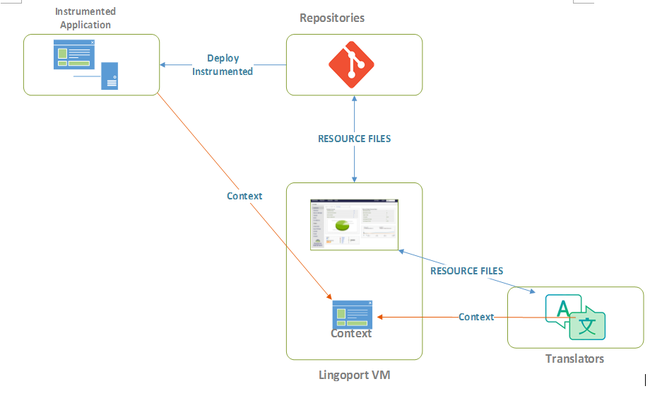Difference between revisions of "InContext Translation Installation"
| (17 intermediate revisions by 3 users not shown) | |||
| Line 1: | Line 1: | ||
| + | =Overview= |
||
| − | |||
| − | |||
| − | = Goals = |
||
| − | * The Lingoport InContext Translation allows for a better-quality translation earlier with possibly reduced need for downstream Linguistic QA. Lingoport is not a translation company or a TMS vendor. The aim of In Context Translation is to provide TMS with the ability to associate segments with context. |
||
| − | |||
| − | = Benefits = |
||
| − | * |
||
| − | |||
| − | = System Overview = |
||
[[File:Lingoport_incontext_translation.png|650px]] |
[[File:Lingoport_incontext_translation.png|650px]] |
||
| + | The InContext Translation process: |
||
| − | For an on-boarded repository, the happy path looks like: |
||
| − | + | #Base and target resource files are instrumented by Localyzer and pushed to the code repository. |
|
| − | + | #The instrumented resource files are deployed in a test build of the web application. |
|
| + | #Using a Chrome browser extension, InContext Capture, the resource files and their context are captured and stored at the InContext Server (which may reside on the Lingoport Server). |
||
| − | * LRM pushes the instrumented files to the repository |
||
| + | #Localyzer sends the resource files with their context to the TMS. |
||
| − | * An instrumented build gets deployed |
||
| − | * With each navigation to a new page on the instrumented deployment, InContext Capture chrome extension saves the context back to the Lingoport VM and sends the association between the context and each of the base resources |
||
| − | * When files are sent to translation, each segment may have a context, a URL, pointing back to a Lingoport Context Server |
||
| + | =Installation= |
||
| − | [[InContext_Capture_Installation]] |
||
| + | InContext Translation is made up of three components that must be installed: |
||
| + | * [[Localyzer Instrumentation | InContext Localyzer Instrumentation]] - The first thing to do is verify that you are using an Localyzer version and license for InContext Translation. |
||
| + | * [[InContext_Server_Installation|InContext Server]] - InContext Server manages the resources identified by InContext Capture. |
||
| + | * [[InContext_Capture_Installation|InContext Capture]] - InContext Capture uses a Chrome extension to identify application resources and send the text and context to the InContext Server. |
||
| + | =InContext Integration with TMSs= |
||
| − | [[InContext_Server_Installation]] |
||
| + | * [[Lingoport_InContext_Plugin_for_Trados_Studio | Lingoport InContext Plugin for Trados Studio]] |
||
Latest revision as of 20:31, 23 February 2021
Overview
The InContext Translation process:
- Base and target resource files are instrumented by Localyzer and pushed to the code repository.
- The instrumented resource files are deployed in a test build of the web application.
- Using a Chrome browser extension, InContext Capture, the resource files and their context are captured and stored at the InContext Server (which may reside on the Lingoport Server).
- Localyzer sends the resource files with their context to the TMS.
Installation
InContext Translation is made up of three components that must be installed:
- InContext Localyzer Instrumentation - The first thing to do is verify that you are using an Localyzer version and license for InContext Translation.
- InContext Server - InContext Server manages the resources identified by InContext Capture.
- InContext Capture - InContext Capture uses a Chrome extension to identify application resources and send the text and context to the InContext Server.
